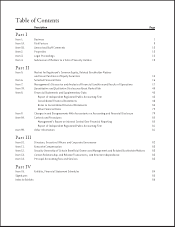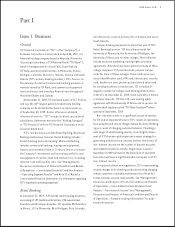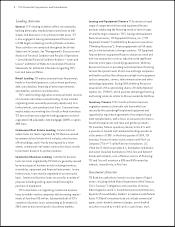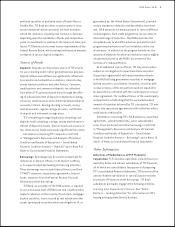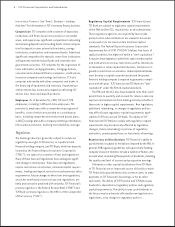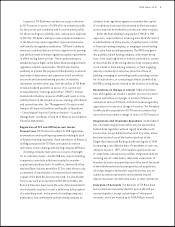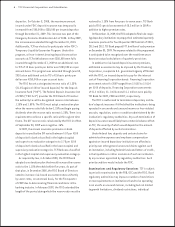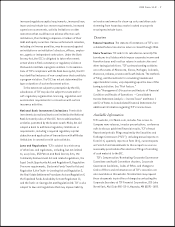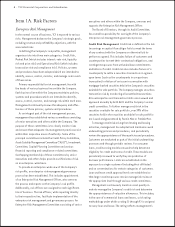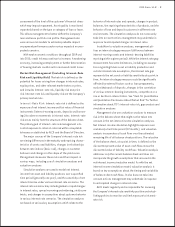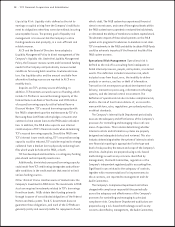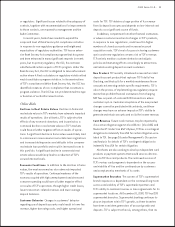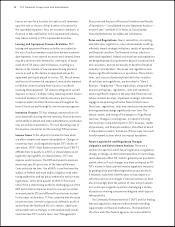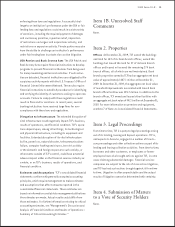TCF Bank 2009 Annual Report Download - page 26
Download and view the complete annual report
Please find page 26 of the 2009 TCF Bank annual report below. You can navigate through the pages in the report by either clicking on the pages listed below, or by using the keyword search tool below to find specific information within the annual report.
10 : TCF Financial Corporation and Subsidiaries
Liquidity Risk Liquidity risk is dened as the risk to
earnings or capital arising from the Company’s inability to
meet its obligations when they come due without incurring
unacceptable losses. The primary goal of liquidity risk
management is to ensure that the Company’s entire
funding needs are met promptly, in a cost-efcient and
reliable manner.
ALCO and the Board of Directors have adopted a
Liquidity Management Policy to direct management of the
Company’s liquidity risk. Under the Liquidity Management
Policy, the Treasurer reviews current and forecasted funding
needs for the Company and periodically reviews market
conditions for issuing debt securities to wholesale inves-
tors. Key liquidity ratios and the amount available from
alternative funding sources are reported to ALCO on a
monthly basis.
Deposits are TCF’s primary source of funding. In
addition, TCF maintains secured sources of funding, which
include $1.9 billion in secured borrowing capacity at the
Federal Home Loan Bank of Des Moines and $708 million
of secured borrowing capacity at the Federal Reserve
Discount Window. TCF’s secured borrowing capacity with
the FHLB is dependent upon the maintenance by TCF of a
Borrowing Base Certicate which pledges consumer and
commercial real estate loans to the FHLB under a blanket
lien. In addition, the FHLB relies upon its own internal
credit analysis of TCF’s nancial results when determining
TCF’s secured borrowing capacity. Should the FHLB lower
TCF’s internal issuer credit rating, TCF’s secured borrowing
capacity could be reduced, TCF could be required to change
collateral from a blanket lien to physically delivering loan
les which would be held at the FHLB, or both.
TCF has developed and maintains a contingency funding
plan should certain liquidity needs arise.
Additionally, diminished unsecured borrowing capacity
could result from TCF credit rating downgrades and unfavor-
able conditions in the credit markets that restrict or limit
various funding sources.
Other Market Risks Another source of market risk is the
Company’s investment in FHLB stock. The investments in FHLB
stock are required investments related to TCF’s borrowings
from these banks. FHLBs obtain their funding primarily
through issuance of consolidated obligations of the Federal
Home Loan Bank system. The U.S. Government does not
guarantee these obligations, and each of the 12 FHLBs are
generally jointly and severally liable for repayment of each
other’s debt. The FHLB system has experienced nancial
stress in recent years, and some of the regional banks within
the FHLB system have suspended or reduced their dividends,
or eliminated the ability of members to redeem capital stock.
The ultimate impact of these developments on the FHLB
system or its programs for advances to members is not clear.
TCF’s investments in the FHLB and ability to obtain FHLB funds
could be adversely impacted if the nancial health of the
FHLB system worsens.
Operational risk is
dened as the risk of loss resulting from inadequate or
failed internal processes, people, and systems, or external
events. This denition includes transaction risk, which
includes losses from fraud, error, the inability to deliver
products or services, and loss or theft of information.
Transaction risk encompasses product development and
delivery, transaction processing, information technology
systems, and the internal control environment. The
denition of operational risk also includes compliance risk,
which is the risk of loss from violations of, or nonconfor-
mance with laws, rules, regulations, prescribed practices,
or ethical standards.
The Company’s Internal Audit Department periodically
assesses the adequacy and effectiveness of the Company’s
processes for controlling and managing risks in all core
areas of operations. This includes determining whether
internal controls and information systems are properly
designed and adequately tested and reviewed. This also
includes determining whether the system of internal controls
over nancial reporting is appropriate for the type and
level of risks posed by the nature and scope of the Company’s
activities. Audit plans are prepared using a risk-based
methodology as well as any concerns identied by
management, the Audit Committee, regulators or the
Company’s independent registered public accounting rm.
Signicant issues related to the adequacy of controls,
together with recommendations for improvements to
those controls, are reported to management and the
Audit Committee.
The Company’s Compliance Department and others
charged with compliance responsibilities periodically
assess the adequacy and effectiveness of the Company’s
processes for controlling and managing its principal
compliance risks. Compliance Department audit plans are
prepared using a risk-based methodology as well as any
concerns identied by management, the Audit Committee,


